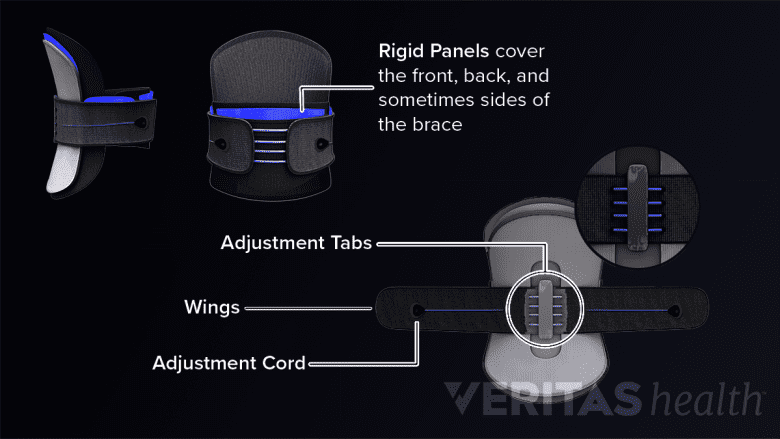Lower back braces vary in composition to help address a range of back pain conditions, from severe muscle strain to postoperative healing. Most back braces are made from similar materials, but differ in their rigidity and postural control.
See Pulled Back Muscle and Lower Back Strain
Generally, back braces are categorized as flexible, semi-rigid, and rigid. Rigid braces tend to be used for moderate to severe cases of pain and/or instability, such as to assist healing of spinal fractures or after back surgery. Semi-rigid and flexible braces are used for more mild or moderate pain.
In This Article:
- Using a Back Brace for Lower Back Pain Relief
- Types of Back Braces Used for Lower Back Pain Relief
- When to Consider a Back Brace
- How to Use and Wear a Lower Back Brace
Flexible Back Braces for Lower Back Pain

Flexible orthoses are made of a soft material, such as cotton/elastic blends, canvas, and/or neoprene (a type of synthetic, flexible rubber). These braces include corsets, lumbar belts, and sacroiliac belts.
Flexible lumbar belts or corsets typically come in a variety of sizes and designs. A corset brace looks similar to a woman's corset, and allows for some limited bending. Corsets typically include vertical metal or plastic stays at the front, back, and/or sides of the brace that provide stability and some motion restriction.
Lumbar belts and sacroiliac belts provide somewhat more restriction in movement, and are typically made of a sturdier fabric without stays.
Flexible corsets and belts can help relieve lower back pain by:
- Applying light pressure to the torso to help adjust posture and shift weight off of the spinal column
- Providing some added spinal support to take pressure off of weakened or injured muscles
- Moderately limiting range of motion to allow for some bending and twisting. For instance, while wearing a flexible brace, it may be possible to bend forward enough to touch the top of the knee, but not past the knees
- Reducing micro-motion at a loose or weakened joint through compression of the torso or pelvis (especially in lumbar and sacroiliac joint belts)
- Relaxing tense muscles through the warmth of the brace
It is recommended to consult with a doctor on the appropriate size and fit of a flexible brace to ensure the brace is safe to use and likely to provide effective pain relief.
Rigid and Semi-Rigid Orthoses for Lower Back Pain
Rigid braces consist of a sturdy layer of material (typically cotton or canvas) that wraps around the torso, and includes rigid panels that cover the front, back, and sometimes sides of the brace. Some models include hard plastic or metal bars that cover the outside of the brace.
A back brace that combines elements of both flexible and rigid orthoses may be referred to as a semi-rigid brace. For instance, a flexible lumbar belt may include additional padding or molded plastic inserts for some additional support and stability.
Rigid and semi-rigid braces help relieve lower back pain by:
- Applying pressure to the torso to hold the spine in a healthy posture and shift weight from the spinal column to the abdomen
- Providing significant support to take pressure off of weakened or injured spinal structures, including the muscles, joints, discs, and nerve roots
- Significantly reducing range of motion to prevent most forward, backward, and side-to-side bending, as well as most rotation of the trunk
- Drastically reducing micro-motion at a spinal segment or fracture, improving the chances of successful healing by limiting irritation from the shock of jarring motions
- Reducing muscle tension through the warmth of the brace
In one study, disability index and pain scores improved more when participants used a rigid back brace compared with a flexible brace.1Morrisette D, Cholewicki J, Logan S, Seif G, McGowan S. A randomized clinical trial comparing extensible and inextensible lumbosacral orthoses and standard care alone in the management of lower back pain. Spine (Phila Pa 1976). 2014 October 1; 39(21):1733-42.
A rigid back brace may be custom-made or assembled from a selection of pre-made parts. In either case, a doctor, orthotist who specializes in designing and fitting braces, or other qualified health professional will measure and fit the brace to ensure it is safe, comfortable, and effective.
Typical Components of a Back Brace

Rigid lumbar braces include sturdy side wings, molded plastic back panels, and firm front panels.
Many flexible and rigid models of lumbar orthoses are similar in how they are worn and put on, and consist of a few key parts, including:
- The two “wings,” or sides of the brace, are made of a flexible or sturdy material that wraps around the torso and connects over the abdomen or sides. In some cases, these wings may include additional elements that provide stability and limit movements at the sides of the torso, such as additional panels in rigid braces, or vertical metal or plastic stays in flexible braces.
- Rigid and semi-rigid braces include a stiff back panel, typically made of hard molded plastic, to keep the back in a healthy posture. Braces used for post-operative healing typically include a rigid back panel with an opening over the spine to prevent irritating the surgical wound.
- A sturdy front panel applies pressure to the abdomen. Typically, the front panel is made up of two overlapping Velcro panels where the brace is closed and adjusted, or an additional front panel is included that is inserted into one of the wings.
- Some means of smaller and more precise adjustments to the brace—in many braces, small adjustments are made using a cord and pull tab on either side of the brace.
Some brace models may differ slightly in makeup and function. For specific functions and composition, consult the instructions provided with the brace or by the prescribing doctor.
- 1 Morrisette D, Cholewicki J, Logan S, Seif G, McGowan S. A randomized clinical trial comparing extensible and inextensible lumbosacral orthoses and standard care alone in the management of lower back pain. Spine (Phila Pa 1976). 2014 October 1; 39(21):1733-42.

